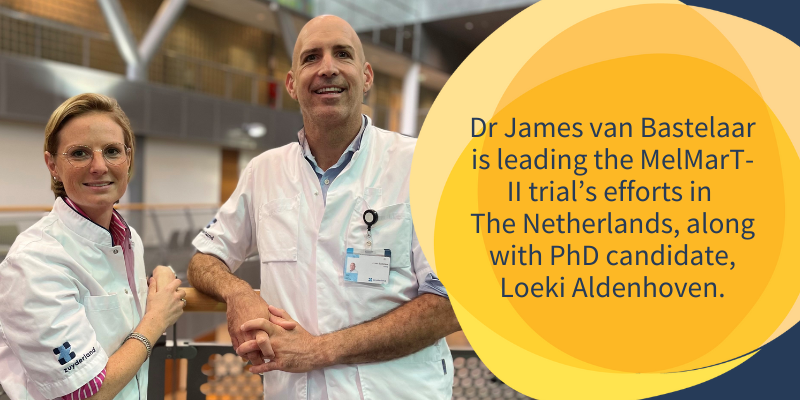Australia and the Netherlands have an alarming statistic in common – melanoma is in their top five most diagnosed cancers. Over 7,500 Dutch and over 17,000 Australians are diagnosed with melanoma each year, and most of these people require surgery to remove the cancer.
Despite melanoma excision surgery being regularly performed in these two countries, they each have different guidelines for the operation. Dutch surgeons typically use a 2cm excision margin for thicker cutaneous melanomas, while Australian surgeons operating on the same size melanoma commonly use a 1cm excision margin.
The melanoma excision margin can have a dramatic impact on a patient’s quality of life, as a larger excision margin on the face can lead to disfigurement, or reduced mobility if surgery is required on the hands or feet. However, if the excision margin is too small, the melanoma could return and metastasise.
To determine the optimal excision margin, clinical teams from both countries are contributing to an international surgical trial led by Melanoma and Skin Cancer Trials (MASC Trials). The MelMarT-II trial is investigating if there is a difference in disease-free survival for patients treated with either a 1cm or 2cm excision margin for stage II primary cutaneous melanoma.
Dutch Principal Investigator from the Zuyderland Medical Centre, Dr James van Bastelaar, is leading the MelMarT-II trial’s efforts in the Netherlands, along with PhD candidate Loeki Aldenhoven.
“Many of our patients who would require reconstructive surgery after a 2cm excision are eager to participate in the trial as it offers them the possibility of downscaling to a 1cm margin and avoiding potential disfigurement,” Dr van Bastelaar said.
“We are always seeking to optimise patient care, so participating in such a large, significant multinational trial that contributes towards an international consensus on melanoma excision margins is important to us.”
“With such a large number of melanoma cases in the Netherlands, we aim to enrol 800 participants across 10 sites as part of the MelMarT-II trial over the next five years,” he added.

The Zuyderland Medical Centre has a specialised melanoma and skin cancer centre where health professionals from many disciplines work closely together to provide the best available treatment for their patients.
As well as contributing to the MelMarT-II trial, the Zuyderland Medical Centre conducts a range of melanoma clinical trials focused on sentinel lymph node biopsy, neoadjuvant immunotherapy, and adjuvant and palliative treatment for other forms of skin cancer.
Australian Trial Co-Chief Investigator, Prof Michael Henderson from the Peter MacCallum Cancer Centre in Melbourne, said this large, multi-centre international trial would provide the evidence required to update clinical practice for melanoma in Australia and world-wide.
“We expect that the MelMarT-II trial results will lead to lower morbidity and guide the management of patients with high-risk primary cutaneous melanoma,” Prof Henderson said.
The trial already has over 800 participants from sites in Australia, New Zealand, USA, UK, Canada, Sweden, Slovenia and The Netherlands, and aims to enrol almost 3,000 participants.
Read more information about the MelMarT-II trial.


